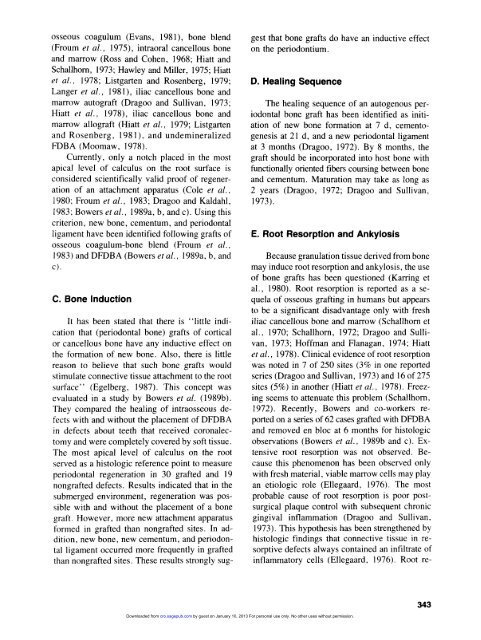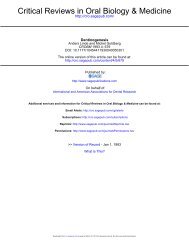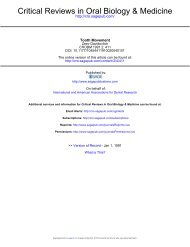Autogenous and Allogeneic Bone Grafts in Periodontal Therapy
Autogenous and Allogeneic Bone Grafts in Periodontal Therapy
Autogenous and Allogeneic Bone Grafts in Periodontal Therapy
Create successful ePaper yourself
Turn your PDF publications into a flip-book with our unique Google optimized e-Paper software.
osseous coagulum (Evans, 1981), bone blend<br />
(Froum et al, 1975), <strong>in</strong>traoral cancellous bone<br />
<strong>and</strong> marrow (Ross <strong>and</strong> Cohen, 1968; Hiatt <strong>and</strong><br />
Schallhorn, 1973; Hawley <strong>and</strong> Miller, 1975; Hiatt<br />
et al., 1978; Listgarten <strong>and</strong> Rosenberg, 1979;<br />
Langer et al., 1981), iliac cancellous bone <strong>and</strong><br />
marrow autograft (Dragoo <strong>and</strong> Sullivan, 1973;<br />
Hiatt et al., 1978), iliac cancellous bone <strong>and</strong><br />
marrow allograft (Hiatt et al., 1979; Listgarten<br />
<strong>and</strong> Rosenberg, 1981), <strong>and</strong> undem<strong>in</strong>eralized<br />
FDBA (Moomaw, 1978).<br />
Currently, only a notch placed <strong>in</strong> the most<br />
apical level of calculus on the root surface is<br />
considered scientifically valid proof of regeneration<br />
of an attachment apparatus (Cole et al.,<br />
1980; Froum et al, 1983; Dragoo <strong>and</strong> Kaldahl,<br />
1983; Bowers et al., 1989a, b, <strong>and</strong> c). Us<strong>in</strong>g this<br />
criterion, new bone, cementum, <strong>and</strong> periodontal<br />
ligament have been identified follow<strong>in</strong>g grafts of<br />
osseous coagulum-bone blend (Froum et al.,<br />
1983) <strong>and</strong> DFDBA (Bowers etal, 1989a, b, <strong>and</strong><br />
c).<br />
C. <strong>Bone</strong> Induction<br />
It has been stated that there is "little <strong>in</strong>dication<br />
that (periodontal bone) grafts of cortical<br />
or cancellous bone have any <strong>in</strong>ductive effect on<br />
the formation of new bone. Also, there is little<br />
reason to believe that such bone grafts would<br />
stimulate connective tissue attachment to the root<br />
surface" (Egelberg, 1987). This concept was<br />
evaluated <strong>in</strong> a study by Bowers et al. (1989b).<br />
They compared the heal<strong>in</strong>g of <strong>in</strong>traosseous defects<br />
with <strong>and</strong> without the placement of DFDBA<br />
<strong>in</strong> defects about teeth that received coronalectomy<br />
<strong>and</strong> were completely covered by soft tissue.<br />
The most apical level of calculus on the root<br />
served as a histologic reference po<strong>in</strong>t to measure<br />
periodontal regeneration <strong>in</strong> 30 grafted <strong>and</strong> 19<br />
nongrafted defects. Results <strong>in</strong>dicated that <strong>in</strong> the<br />
submerged environment, regeneration was possible<br />
with <strong>and</strong> without the placement of a bone<br />
graft. However, more new attachment apparatus<br />
formed <strong>in</strong> grafted than nongrafted sites. In addition,<br />
new bone, new cementum, <strong>and</strong> periodontal<br />
ligament occurred more frequently <strong>in</strong> grafted<br />
than nongrafted sites. These results strongly sug-<br />
gest that bone grafts do have an <strong>in</strong>ductive effect<br />
on the periodontium.<br />
D. Heal<strong>in</strong>g Sequence<br />
The heal<strong>in</strong>g sequence of an autogenous periodontal<br />
bone graft has been identified as <strong>in</strong>itiation<br />
of new bone formation at 7 d, cementogenesis<br />
at 21 d, <strong>and</strong> a new periodontal ligament<br />
at 3 months (Dragoo, 1972). By 8 months, the<br />
graft should be <strong>in</strong>corporated <strong>in</strong>to host bone with<br />
functionally oriented fibers cours<strong>in</strong>g between bone<br />
<strong>and</strong> cementum. Maturation may take as long as<br />
2 years (Dragoo, 1972; Dragoo <strong>and</strong> Sullivan,<br />
1973).<br />
E. Root Resorption <strong>and</strong> Ankylosis<br />
Because granulation tissue derived from bone<br />
may <strong>in</strong>duce root resorption <strong>and</strong> ankylosis, the use<br />
of bone grafts has been questioned (Karr<strong>in</strong>g et<br />
al., 1980). Root resorption is reported as a sequela<br />
of osseous graft<strong>in</strong>g <strong>in</strong> humans but appears<br />
to be a significant disadvantage only with fresh<br />
iliac cancellous bone <strong>and</strong> marrow (Schallhorn et<br />
al., 1970; Schallhorn, 1972; Dragoo <strong>and</strong> Sullivan,<br />
1973; Hoffman <strong>and</strong> Flanagan, 1974; Hiatt<br />
et al., 1978). Cl<strong>in</strong>ical evidence of root resorption<br />
was noted <strong>in</strong> 7 of 250 sites (3% <strong>in</strong> one reported<br />
series (Dragoo <strong>and</strong> Sullivan, 1973) <strong>and</strong> 16 of 275<br />
sites (5%) <strong>in</strong> another (Hiatt et al., 1978). Freez<strong>in</strong>g<br />
seems to attenuate this problem (Schallhorn,<br />
1972). Recently, Bowers <strong>and</strong> co-workers reported<br />
on a series of 62 cases grafted with DFDBA<br />
<strong>and</strong> removed en bloc at 6 months for histologic<br />
observations (Bowers et al., 1989b <strong>and</strong> c). Extensive<br />
root resorption was not observed. Because<br />
this phenomenon has been observed only<br />
with fresh material, viable marrow cells may play<br />
an etiologic role (Ellegaard, 1976). The most<br />
probable cause of root resorption is poor postsurgical<br />
plaque control with subsequent chronic<br />
g<strong>in</strong>gival <strong>in</strong>flammation (Dragoo <strong>and</strong> Sullivan,<br />
1973). This hypothesis has been strengthened by<br />
histologic f<strong>in</strong>d<strong>in</strong>gs that connective tissue <strong>in</strong> resorptive<br />
defects always conta<strong>in</strong>ed an <strong>in</strong>filtrate of<br />
<strong>in</strong>flammatory cells (Ellegaard, 1976). Root re-<br />
Downloaded from<br />
cro.sagepub.com by guest on January 10, 2013 For personal use only. No other uses without permission.<br />
343




